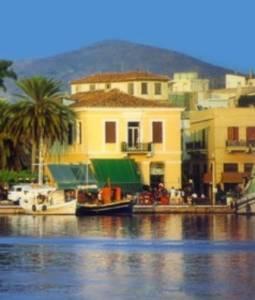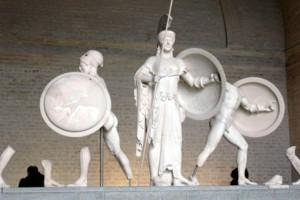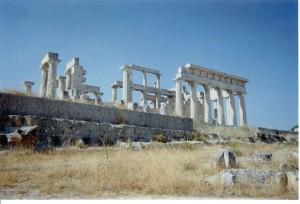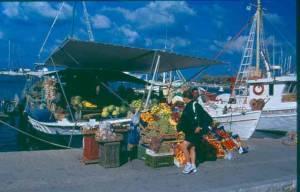Aegina Sightseeing
...Beyond the Temple, and moving northward, is the village of Livadi where Nikos Kazantzakis wrote his famous novel, “Zorba the Greek.”
 If you are planning to spend only a few hours on the island, your visit might include a walk to the Hill of Kolona, overlooking the ancient “secret” port, just north of the present day port of Aegina. Here one can visit the ruins of the ancient city, view the sole remaining column from the Temple of Apollo (still often referred to, in error, as the Temple of Aphrodite), and pay a visit to the interesting Archaeological Museum with exhibits from the Neolithic era to the Classical period. There is also a mosaic recovered from an ancient synagogue. Beyond the Temple, and moving northward, is the village of Livadi where Nikos Kazantzakis wrote his famous novel, “Zorba the Greek.”
With a little more time on your hands, or if this is the main focus of your visit, then you can have the opportunity to cross to the eastern side of the island and visit the famous Temple of Aphaia Athena (photo below) overlooking the picturesque bay lying below the temple, with pine trees sweeping down to the beautiful long sandy beach of Agia Marina. This is the most prominent attraction and most visited site on the island. The Temple is the best preserved of any to be found on the Greek islands, and has 25 of the original 32 columns still standing (some through restoration).  Seventeen marble blocks belonging to the pediments were unearthed by a group of German and British “art lovers” (Baron Haller von Hallerstein and the architect C. R. Cockerell) in 1811. They were transported to Germany, where they were sold to the Royal Prince, Louis of Bavaria. The “art lovers” were able to pocket 120000 golden marks of the time. The pieces were put together by the famous sculptor, Bertel Thorvaldsen, in a controversial way, which involved cutting the original pieces and filling in with new marble. They are now exhibited at the Glyptothek at Munich. (see photo to the right)
Outside the temple are ruins of an ancient wall, a cistern, altars, and remains of some of the priest’s houses. Beyond the Temple and down to the sea is the well-developed seaside resort of Agia Marina. If your stay on the island is for more than a few hours, and if you have at least one overnight, then you must spend some time here. It offers a fantastic beach, water sports, and a very lively nightlife.
The north coast of the island features the Souvala Spa, radioactive baths recommended for the treatment of arthritis and rheumatism. South of Souvala, a road takes you inland to the Byzantine and medieval capital of the island, Palaeochora. Here are the remains of nearly two dozen 13th Century churches, many still containing some beautiful frescoes. Above the old village are the remains of the Venetian castle dating to 1654. Today, visitors must contact the local phylax before  venturing onto the site. From here, you can easily visit one of the most famous monasteries of the region, Agios Nektarios. The most recent of Greek Orthodox saints and the modern-day protector of the island, his remains lie in the sanctuary of a cave on the grounds of the monastery. If you are traveling by public bus, from here you have the option of either returning to the main town to the west, or going eastward to the resort of Agia Marina.
Situated in the southern part of the island, and on the north slope of Mt. Oros, are the chapel of Taxiarchis and the ruins of the third temple of Aegina, dedicated to Zeus. You can reach the area with the bus running from Agia Marina to Perdika. The chapel lies within and atop a large group of Hellenistic structures, originally excavated in the earlier part of the last century. Since 1995, excavations have resumed in an effort to reveal more about the site. There are two terraces; the upper terrace with the chapel shows the large and quite visible foundations of a large building dating to the 2nd Century BC.  The view from the top of the mountain is outstanding, should you be inclined to climb to the top.
If you continue further southwest, you will arrive at the fishing village of Perdika, with its excellent fish tavernas. From here, you can take the boat across of the tiny islet of Moni, an uninhabited island and nature conserve, attracting artists and nature lovers. Chief among the many birds and animals on the island are wild goats, giant hares, pesky peacocks, and miniature horses. There is also a monastery here built by Agios Nektarios, and an old German lookout post from World War II. Though its beaches are nothing special, the sea is crystal clear, and the swimming is superb. |
|



